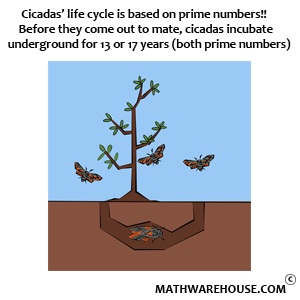Quick Overview
- $$\displaystyle \frac d {dx}\left(b^{kx}\right) = k\ln b\cdot b^{kx}$$
- This lesson assumes you are familiar with the $$\blue{power rule}$$, $$\blue{product rule}$$, $$\blue{quotient rule}$$, and $$\blue{chain rule}$$
Examples
Example 1
Find the derivative of $$f(x) = 2^x$$.
Step 1Change the base to $$e$$
$$ f(x) = \blue 2^x = \blue{(e^{\ln 2})}^x = \blue e^{\blue{(\ln 2)}x} $$
Step 2Differentiate, recalling that $$\frac d {dx} (e^{kx}) = ke^{kx})$$. In this case, $$k = \ln 2$$.
$$ f'(x) = \ln 2\,e^{(\ln 2)x} $$
Step 3Convert the base back to 2.
$$ f'(x) = \ln 2\,\blue e^{\blue{(\ln 2)}x} = \ln 2\blue{\left(e^{\ln 2}\right)}^x = \ln 2(\blue 2^x) $$
Answer$$f'(x) = (\ln 2)\,2^x$$
Example 2
Find the derivative $$f(x) = b^{kx}$$.
Step 1Change the base to $$e$$.
$$ f(x) = \blue b^{kx} = \blue{\left(e^{\ln b}\right)}^{kx} = \blue e^{\blue{(\ln b)}kx} = e^{(k\ln b)\,x} $$
Step 2Differentiate.
$$ \begin{align*} f(x) & = e^{(k\ln b)x}\\[6pt] f'(x) & = (k\ln b) e^{(k\ln b)x} \end{align*} $$
Step 3Convert the base back to $$b$$.
$$ \begin{align*} f'(x) & = (k\ln b) \blue e^{(k\blue{\ln b})x}\\[6pt] & = (k\ln b) \blue e^{\blue{(\ln b)}\,kx}\\[6pt] & = (k\ln b)\blue{\left(e^{\ln b}\right)}^{kx}\\[6pt] & = (k\ln b)\,\blue b^{kx} \end{align*} $$
AnswerThe derivative of $$f(x) = b^{kx}$$ is $$\displaystyle (k\ln b)\,b^{kx}$$.
In General
Suppose $$y = b^{\,g(x)}$$. Then the derivative is $$y' = \ln b\cdot g'(x)\cdot b^{\,g(x)}$$.
Practice Problems
Differentiate.
$$ f'(x) = 9\ln 4\cdot 4^{9x} $$
$$f'(x) = 9\ln 4\cdot 4^{9x}$$
Differentiate.
$$ f'(x) = (7\ln12)\,12^{7x} $$
Evaluate $$f'(0)$$.
$$ f'(0) = (7\ln 12)\,12^0 = 7\ln 12 $$
$$f'(0) = 7\ln 12$$
Differentiate each term.
$$ f'(x) = (2\ln 3)\cdot 3^{2x} + (3\ln 2)\cdot 2^{3x} $$
Evaluate $$f'(1)$$
$$ \begin{align*}% f'(1) & = (2\ln 3)\cdot 3^{2(1)} + (3\ln 2)\cdot 2^{3(1)}\\[6pt] & = (2\ln 3)\cdot 3^2 + (3\ln 2)\cdot 2^3\\[6pt] & = (2\ln 3)\cdot 9 + (3\ln 2)\cdot 8\\[6pt] & = 18\ln 3 + 24\ln 2\\[6pt] \end{align*} $$
$$ f'(1) = 18\ln 3 + 24\ln 2 $$
Differentiate each term.
$$ \begin{align*}% f'(x) & = 9\cdot 4e^{4x} - 2(8\ln 5)\cdot 5^{8x}\\[6pt] & = 36e^{4x} - (16\ln 5)\cdot 5^{8x} \end{align*} $$
$$f'(x) = 36e^{4x} - (16\ln 5)\cdot 5^{8x}$$
Identify the factors in the function.
$$ f(x) = \blue{4x^3}\red{(2^{-6x})} $$
Differentiate using the product rule.
$$ f'(x) = \blue{12x^2}(2^{-6x}) + 4x^3\red{(-6\ln 2)\cdot 2^{-6x}} $$
Simplify by factoring.
$$ \begin{align*} f'(x) & = 12x^2\blue{(2^{-6x})} + 4x^3(-6\ln 2)\cdot \blue{2^{-6x}}\\[6pt] & = \blue{(2^{-6x})}\left[12\red{x^2} + 4\red{x^3}(-6\ln 2)\right]\\[6pt] & = \red{x^2}(2^{-6x})\left[12 + 4x(-6\ln 2)\right]\\[6pt] & = x^2(2^{-6x})\left[12 - (24\ln 2)x\right]\\[6pt] \end{align*} $$
$$f'(x) = x^2(2^{-6x})\left[12 - (24\ln 2)x\right]$$
Identify the factors in the function.
$$ f(x) = \blue{\sin 9x}\,\red{(2^{-0.3x})} $$
Differentiate using the product rule.
$$ \begin{align*}% f'(x) & = \blue{9\cos 9x}\,(2^{-0.3x}) + \sin 9x\,\red{(-0.3\ln 2)\cdot 2^{-0.3x}}\\[6pt] & = 9\cos 9x\,(2^{-0.3x}) + (-0.3\ln 2)\sin 9x\cdot 2^{-0.3x}\\[6pt] & = 9\cos 9x\,(2^{-0.3x}) -0.3\ln 2\sin 9x\, (2^{-0.3x}) \end{align*} $$
(Optional) Simplify by factoring.
$$ \begin{align*} f'(x) & = 9\cos 9x\,\blue{(2^{-0.3x})} -0.3\ln 2\sin 9x\, \blue{(2^{-0.3x})}\\[6pt] & = \blue{2^{-0.3x}}\left(9\cos 9x - \frac 3 {10}\ln 2\sin 9x\right)\\[6pt] & = \frac 3 {10}(2^{-0.3x})\left(30\cos 9x - \ln 2\sin 9x\right) \end{align*} $$
$$ \displaystyle f'(x) = \frac 3 {10}(2^{-0.3x})\left(30\cos 9x - \ln 2\sin 9x\right) $$
Differentiate using the quotient rule. The parts in $$\blue{blue}$$ are associated with the numerator.
$$ \begin{align*} f'(x) & = \frac{(2+4^{-2x})\blue{(-2\ln 4)4^{-2x}} - \blue{4^{-2x}}(-2\ln 4)4^{-2x}}{(2+4^{-2x})^2} \end{align*} $$
Simplify using factoring.
$$ \begin{align*} f'(x) & = \frac{(2+4^{-2x})(-2\ln 4)\blue{4^{-2x}} - \blue{4^{-2x}}(-2\ln 4)4^{-2x}}{(2+4^{-2x})^2}\\[6pt] & = \frac{\blue{4^{-2x}}\left[(2+4^{-2x})\red{(-2\ln 4)} - \red{(-2\ln 4)}4^{-2x}\right]}{(2+4^{-2x})^2}\\[6pt] & = \frac{\red{(-2\ln 4)}4^{-2x}\left[(2+4^{-2x}) - 4^{-2x}\right]}{(2+4^{-2x})^2}\\[6pt] & = \frac{(-2\ln 4)4^{-2x}\left[2+4^{-2x} - 4^{-2x}\right]}{(2+4^{-2x})^2}\\[6pt] & = \frac{(-2\ln 4)4^{-2x}(2)}{(2+4^{-2x})^2}\\[6pt] & = -\frac{(4\ln 4)4^{-2x}}{(2+4^{-2x})^2}\\[6pt] \end{align*} $$
$$\displaystyle f'(x) = -\frac{(4\ln 4)4^{-2x}}{(2+4^{-2x})^2}$$
Differentiate using the quotient rule. The parts in $$\blue{blue}$$ are associated with the numerator.
$$ \begin{align*} f'(x) & = \frac{(x^2+1)\blue{(2\ln 5)5^{2x}} - \blue{5^{2x}}\cdot 2x}{(x^2+1)^2} \end{align*} $$
Simplify by factoring.
$$ \begin{align*} f'(x) & = \frac{(x^2+1)(2\ln 5)\blue{5^{2x}} - \blue{5^{2x}}\cdot 2x}{(x^2+1)^2}\\[6pt] & = \frac{\blue{5^{2x}}\left[(x^2+1)(\red 2\ln 5) - \red 2x\right]}{(x^2+1)^2}\\[6pt] & = \frac{\red 2 \left(5^{2x}\right)\left[(x^2+1)(\ln 5) - x\right]}{(x^2+1)^2}\\[6pt] & = \frac{2 \left(5^{2x}\right)\left[(\ln 5)x^2 - x +\ln 5\right]}{(x^2+1)^2} \end{align*} $$
$$\displaystyle f'(x) = \frac{2 \left(5^{2x}\right)\left[(\ln 5)x^2 - x +\ln 5\right]}{(x^2+1)^2}$$


















